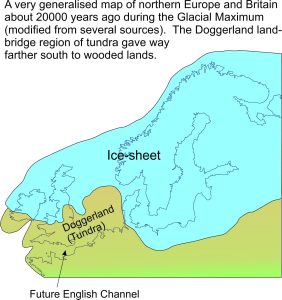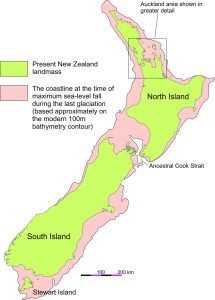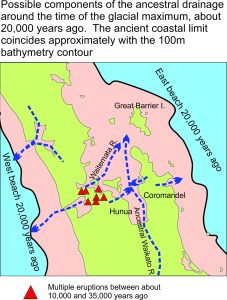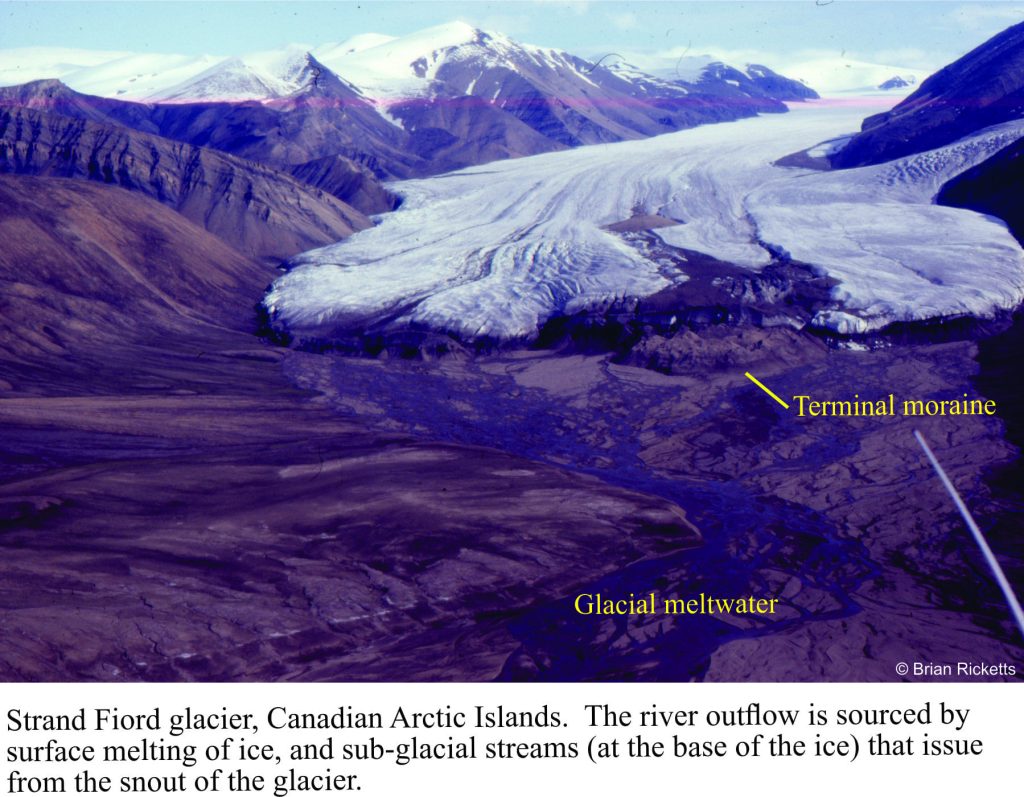A short hike to the beach 20,000 years ago
The Last Glaciation began about 110,000 years ago with massive expansion of ice-sheets in northern Europe, north Asia, North America and Antarctica. The source of water for the ice-sheets was the oceans. Based on geological mapping, dating of glacial deposits, and other physical evidence for ice movement it has been determined that the maximum extent of glacial ice from a global perspective occurred about 20000 years ago; this is referred to as the Late Glacial Maximum or (LGM). Mapping also indicates that global sea-level was on average about 100m -120m below present sea-level.
Physical evidence for the LGM
Ice-sheets and glaciers leave tell-tale signs that they might once have passed this way;
- Carved U-shape valleys and broad plateaus, or rounded knobs of bedrock (called roche moutonnées)
- Large scratches (striae) caused by the ice dragging (very slowly) chunks of rock across polished bedrock surfaces, and
- Sedimentary deposits most commonly made up of mud mixed with sand, cobbles and boulders (given the generic name diamictite), that accumulate in moraines (see the image above).
There were also cold and wind-swept land areas beyond the ice-sheets. In fact, there was a huge expansion of land beyond present coastlines that was exposed as sea-level fell. The evidence for this is both geological and archeological.
By examining sedimentary deposits, fossils (various shelly materials, microscopic fossils, fossil pollen, bones, wood) and artefacts, we can determine whether the environment 20,000 years ago was marine (e.g. beach and offshore sands), brackish (marshes, estuaries) or terrestrial (swamps, rivers, wetlands). An important observation in this kind of analysis is the spatial relationship among these different deposits, where we might see a progression from offshore marine to beach, passing landward to estuarine or lagoonal and eventually to freshwater swamps and rivers. Radiocarbon dating of fossil wood, shell and bone provides the actual ages for these different deposits.
Exposure of the continental shelf during the 100m -120m fall in sea level is well documented in many places around the world. However, there are two locations worthy of mention.
The Doggerland Land-Bridge
 At the time of the LGM, the Doggerland land-bridge stretched from southern Britain and Ireland to Netherlands and neighbouring lowland areas of northern Europe; it was located in what is now the southern North Sea and English Channel. The land-bridge was a large area exposed as sea-level fell, with its maximum land extent about 20,000 years ago. It was inhabited by Mesolithic people and animals. Not only are there sediments indicating exposed land (e.g. soils, peats), but artefacts are frequently recovered by fishermen from large tracts of the land-bridge that now are submerged beneath the North Sea.
At the time of the LGM, the Doggerland land-bridge stretched from southern Britain and Ireland to Netherlands and neighbouring lowland areas of northern Europe; it was located in what is now the southern North Sea and English Channel. The land-bridge was a large area exposed as sea-level fell, with its maximum land extent about 20,000 years ago. It was inhabited by Mesolithic people and animals. Not only are there sediments indicating exposed land (e.g. soils, peats), but artefacts are frequently recovered by fishermen from large tracts of the land-bridge that now are submerged beneath the North Sea.
Most of Doggerland was flooded by about 5500 BC during the post-glacial rise in sea-level. This means that Doggerland was home to people and tundra animals for several thousand years. The end in fact may have been catastrophic; studies suggest that the remaining land area was inundated by a tsunami caused by a massive landslide near Norway (reported by Paul Rincon, BBC, 2014).
The Bering Land-Bridge
A classic example of the importance of lower sea-level during the glacial maximum is the Bering Land Bridge (also known as Beringia), that allowed migration of people from north Asia to the Americas. However, in this part of the glacial world, folks migrating to Alaska and beyond would also have needed to contend with the cold associated with the massive Laurentide Ice-sheet that covered most of Alaska, Canada, and parts of northern US. Recent DNA sequencing indicates the possibility that the land bridge was not only a route for migration, but actually a place to live for several thousand years.
Walking to Great Barrier Island
 The North and South islands and Stewart Island of New Zealand, that presently are separated by seaways, were connected by land-bridges during the LGM. Although there were no ice-sheets over New Zealand, the South Island glaciers were significantly expanded at the time of the glacial maximum.
The North and South islands and Stewart Island of New Zealand, that presently are separated by seaways, were connected by land-bridges during the LGM. Although there were no ice-sheets over New Zealand, the South Island glaciers were significantly expanded at the time of the glacial maximum.
What did greater Auckland look like 20,000 years ago? With sea levels 100-120m lower, the LGM coastline would have extended well beyond Coromandel and Great Barrier Island. It would have been a pretty decent hike from the ancestral Auckland CBD to Great Barrier Island (about 80 km), notwithstanding the need to ford several ancestral rivers. At this time the ancestral Waikato River coursed its way through Hinuera and Hauraki Plains, and thence to Hauraki Gulf. Twenty thousand years ago the Waikato would have been a pretty major water system, potentially extending into the northern part of the Gulf. Many tributaries would have contributed to the ancestral Waikato flow from the western hills of Coromandel and the eastern Hunua hills. Other ancestral rivers such as the Waitemata River also would have drained eastwards, all the while carving valleys and ridges. And if you had decided to make for west coast beaches, Raglan or Piha, for a spot of surfing then an additional 20-30km hike was ahead of you.
 Volcanic eruptions in the Auckland area would have influenced not only the drainage but also the landscape with the construction of cones, the effusion of lava flows, explosive ash clouds, and air-fall deposits of ash. Several eruptions within an age range of 35000 to 10000 years ago, thus bracketing the glacial maximum, took place when the nearest east coast beach would have been closer to Coromandel. Other eruptions were to come later. By the time Rangitoto erupted about 600 years ago, sea level would have risen pretty close to its present level.
Volcanic eruptions in the Auckland area would have influenced not only the drainage but also the landscape with the construction of cones, the effusion of lava flows, explosive ash clouds, and air-fall deposits of ash. Several eruptions within an age range of 35000 to 10000 years ago, thus bracketing the glacial maximum, took place when the nearest east coast beach would have been closer to Coromandel. Other eruptions were to come later. By the time Rangitoto erupted about 600 years ago, sea level would have risen pretty close to its present level.
A review of data for the Auckland volcanic field is available here.
The ancient river valleys were subsequently drowned as sea level rose towards its present level (melting of ice-sheets began about 18-19,000 years ago). The result was the beautifully intricate Auckland coastline with many embayments, pocket beaches, estuaries and islands (fantastic havens for sail boats). This drowned valley landscape extends into the far north of North Island.
Of course, if the present climate change predictions are true, sea level will continue to rise and drown even more of this landscape, pushing beaches and baches (the New Zealand term for holiday homes) farther landward.



















1 thought on “Walking to Great Barrier Island”
Pingback: mink lashes